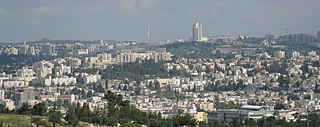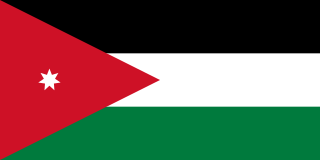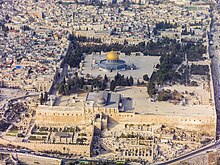
Jerusalem is a city in Western Asia. Situated on a plateau in the Judaean Mountains between the Mediterranean and the Dead Sea, it is one of the oldest cities in the world, and is considered holy for the three major Abrahamic religions: Judaism, Christianity, and Islam. The city straddles the Green Line between Israel and the West Bank; both Israelis and Palestinians claim Jerusalem as their capital, as Israel controls the entire city and maintains its primary governmental institutions there while the Palestinian National Authority and Palestine Liberation Organization ultimately foresee it as the seat of power for the State of Palestine. Due to this long-running dispute, neither claim is widely recognized internationally.

United Nations Security Council Resolution 242 (S/RES/242) was adopted unanimously by the UN Security Council on November 22, 1967, in the aftermath of the Six-Day War. It was adopted under Chapter VI of the UN Charter. The resolution was sponsored by British ambassador Lord Caradon and was one of five drafts under consideration.

The United Nations Truce Supervision Organization (UNTSO) is an organization founded on 29 May 1948 for peacekeeping in the Middle East. Established amidst the 1948 Arab–Israeli War, its primary task was initially to provide the military command structure to the peacekeeping forces in the Middle East to enable the peacekeepers to observe and maintain the ceasefire, and in assisting the parties to the Armistice Agreements in the supervision of the application and observance of the terms of those Agreements. The organization's structure and role has evolved over time as a result of the various conflicts in the region and at times UNTSO personnel have been used to rapidly deploy to other areas of the Middle East in support of other United Nations operations. The command structure of the UNTSO was maintained to cover the later peacekeeping organisations of the United Nations Disengagement Observer Force (UNDOF) and the United Nations Interim Force in Lebanon (UNIFIL) to which UNTSO continues to provide military observers.

The term "Palestinian territories" has been used for many years to describe the territories occupied by Israel since 1967 within the former British Mandate for Palestine, namely the West Bank and the Gaza Strip. The International Court of Justice (ICJ) has referred to the West Bank, including East Jerusalem, as "the Occupied Palestinian Territory" and this term was used as the legal definition by the ICJ in the ruling in July 2004. More recently, the official United Nations (UN) terminology has been used, occupied Palestinian territory increasingly replacing other terms since 1999. The European Union (EU) also has adopted this usage. The term Occupied Palestinian Territory was used by the UN and other international organizations between October 1999 and December 2012 to refer to areas controlled by the Palestinian National Authority. The EU had utilized a parallel term Palestinian Authority territories occasionally during the same period.

The Old City is a 0.9-square-kilometre (0.35 sq mi) walled area within the modern city of Jerusalem.

East Jerusalem or Eastern Jerusalem is the sector of Jerusalem that was occupied by Jordan during the 1948 Arab–Israeli War, as opposed to the western sector of the city, West Jerusalem, which was occupied by Israel. Since the 1967 Arab–Israeli War, East Jerusalem has been considered to be occupied by Israel by the international community.

Jerusalem Day is an Israeli national holiday commemorating the reunification of Jerusalem and the establishment of Israeli control over the Old City in the aftermath of the June 1967 Six-Day War. The day is officially marked by state ceremonies and memorial services.

The Jordanian annexation of the West Bank formally occurred on 24 April 1950, after the 1948 Arab–Israeli War, during which Transjordan occupied territory that had previously been part of Mandatory Palestine and had been earmarked by the UN General Assembly Resolution 181 of 29 November 1947 for an independent Arab state to be established there alongside a Jewish state mainly to its west. During the war, Jordan's Arab Legion took control of territory on the western side of the Jordan River, including the cities of Jericho, Bethlehem, Hebron, Nablus and eastern Jerusalem, including the Old City. Following the end of hostilities, the area that remained under Jordanian control became known as the West Bank.
The International law bearing on issues of Arab–Israeli conflict, which became a major arena of regional and international tension since the birth of Israel in 1948, resulting in several disputes between a number of Arab countries and Israel.
The Green Line, (pre-)1967 border, or 1949 Armistice border, is the demarcation line set out in the 1949 Armistice Agreements between the armies of Israel and those of its neighbors after the 1948 Arab–Israeli War. It served as the de facto borders of the State of Israel from 1949 until the Six-Day War in 1967.

The Israeli-occupied territories refers to the territories occupied by Israel during the Six-Day War of 1967. It also sometimes refers to areas of Southern Lebanon where Israeli military was present to support local Lebanese militias during the civil war and after it. Originally, the sole governance of the territories were as the Jordanian-annexed West Bank, the Egyptian-occupied Gaza Strip, the Egyptian Sinai Peninsula, and the Syrian Golan Heights. The first use of the term 'territories occupied' was in United Nations Security Council Resolution 242 following the Six-Day War in 1967, which called for "the establishment of a just and lasting peace in the Middle East" to be achieved by "the application of both the following principles: ... Withdrawal of Israeli armed forces from territories occupied in the recent conflict ... Termination of all claims or states of belligerency" and respect for the right of every state in the area to live in peace within secure and recognized boundaries. In addition to the territories occupied following the Six-Day War, Israel also occupied portions of Southern Lebanon following the 1982 Lebanon War, and maintained a military presence there until withdrawing in 2000.

The Jewish Quarter is one of the four traditional quarters of the Old City of Jerusalem. The 116,000 square meter area lies in the southeastern sector of the walled city, and stretches from the Zion Gate in the south, along the Armenian Quarter on the west, up to the Street of the Chain in the north and extends to the Western Wall and the Temple Mount in the east. In the early 20th century the Jewish population of the quarter reached 19,000; although prior to 1948 Jewish-owned property amounted to less than 20% of the quarter.

The Allon Plan was a plan to partition the West Bank between Israel and the Hashemite Kingdom of Jordan, create a Druze state in the Israeli-occupied Golan Heights, and return most of the Sinai Peninsula to Arab control. The plan was drafted by Israeli Minister Yigal Allon shortly after the Six-Day War in June 1967.

The status of Jerusalem is disputed in both international law and diplomatic practice, with both the Israelis and Palestinians claiming Jerusalem as their capital city. The dispute has been described as "one of the most intractable issues in the Israeli–Palestinian conflict", with conflicting claims to sovereignty over the city or parts of it, and access to its holy sites. The main dispute revolves around the legal status of East Jerusalem and especially the Old City of Jerusalem, while broader agreement exists regarding future Israeli presence in West Jerusalem in accordance with Israel's internationally recognised borders. The majority of United Nations (UN) member states hold the view that the final status of Jerusalem should be resolved through negotiation, and have therefore favored locating their embassies in Tel Aviv prior to a final status agreement. However, in the late 2010s, the international consensus to abstain from expressing a viewpoint on the city's final status has shown signs of fragility, with Russia, the United States, and Australia adopting new policy positions. Furthermore, the proposal that Jerusalem should be the future capital of both Israel and Palestine has also gained international support, with endorsements coming from both the United Nations and the European Union.
Corpus separatum was the internationalisation proposal for Jerusalem and the surrounding area as part of the United Nations Partition Plan for Palestine, which was adopted by the UN General Assembly with a two-thirds majority in November 1947. According to the UN Plan, the Jerusalem area would be under an international regime, conferring it a special status due to its shared religious importance. The corpus separatum was one of the main issues of the Lausanne Conference of 1949, besides the other borders and the question of the right of return of Palestinian refugees.

The Golan Heights, or simply the Golan, is a region in the Levant spanning about 1,800 square kilometres (690 sq mi). The region defined as the Golan Heights differs between disciplines: as a geological and biogeographical region, the Golan Heights refers to a basaltic plateau bordered by the Yarmouk River in the south, the Sea of Galilee and Hula Valley in the west, the Anti-Lebanon with Mount Hermon in the north and Wadi Raqqad in the east. As a geopolitical region, the Golan Heights refers to the border region captured from Syria by Israel during the Six-Day War of 1967; the territory has been occupied by the latter since then and was subject to a de facto Israeli annexation in 1981. This region includes the western two-thirds of the geological Golan Heights and the Israeli-occupied part of Mount Hermon.

Nahman Avigad, born in Zawalow, Galicia, was an Israeli archaeologist.

The modern borders of Israel exist as the result both of past wars and of diplomatic agreements between the State of Israel and its neighbours as well as colonial powers. Only two of Israel's five total potential land borders are internationally recognized and uncontested, while the other three remain disputed; the majority of its border disputes are rooted in territorial changes that came about as a result of the 1967 Arab–Israeli War, which saw Israel occupy large swathes of territory from its rivals. Israel's two formally recognized and confirmed borders exist with Egypt and Jordan since the 1979 Egypt–Israel peace treaty and the 1994 Israel–Jordan peace treaty, while its borders with Syria, Lebanon and the Palestinian territories remain internationally recognized as contested.

The Broad Wall is an ancient defensive wall in the Old City of Jerusalem's Jewish Quarter. The wall was unearthed in the 1970s by Israeli archaeologist Nahman Avigad and dated to the reign of King Hezekiah.

City Line is the name given to a segment of the Green Line that divided the city of Jerusalem from 1948 to 1967. It was 7 km in length, and constituted a temporary boundary line in accordance with Israel's Armistice Agreement with Jordan, which divided the city between East Jerusalem which was part of the Kingdom of Jordan, and West Jerusalem, the capital of the State of Israel. The Old City bordered the City line on the east side, and thus had been part of the "Jordanian Jerusalem". On both sides of the City line fortifications and obstacles were deployed, and different buildings in the city along the line were used as military posts.

















